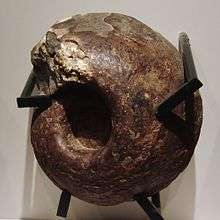Fagesia
Fagesia is a small, subglobular ammonite (suborder Ammonitina) belonging to the vascoceratid family of the Acanthocerataceae that lived during the Turonian stage of the Late Cretaceous, 92-88 Ma ago.
| Fagesia | |
|---|---|
 | |
| Fossil of Fagesia spheroidalis from Japan. Late Cretaceous. Exhibit in the National Museum of Nature and Science, Tokyo, Japan | |
| Scientific classification | |
| Kingdom: | |
| Phylum: | |
| Class: | |
| Subclass: | |
| Order: | |
| Superfamily: | |
| Family: | |
| Genus: | Fagesia Pervinquière 1907 |
| Species | |
|
See text | |
The shell of Fagesia is about 9.5 cm (3.47 in) in diameter, typically with blunt umbilical tubercles from which spring 2 or three ribs each, but which are lost in the late growth stage. The suture is ammonitic with long spikey lobes and saddles with rounded subelements.
Species
- †Fagesia catinus Mantell 1822 - Loma Gorda Formation, Colombia
- †Fagesia fleuryi Pervinquière 1907
- †Fagesia peroni Pervinquière 1907
- †Fagesia pervinquieri Bose 1920
- †Fagesia rudra Stoliczka 1865
- †Fagesia spheroidalis Pervinquière 1907
- †Fagesia superstes Kossmat 1897
- †Fagesia tevesthensis Peron 1896
Distribution
Fossils of Fagesia have been found in Brazil, Colombia (El Colegio, Cundinamarca, La Frontera (Cundinamarca, Huila and Boyacá),[1] and Loma Gorda Formations, Aipe, Huila),[2] Egypt, France, Mexico, Morocco, Nigeria, Oman, Romania, the Russian Federation, Tunisia, United States (Arizona, California, Colorado, New Mexico, Texas), and Venezuela.[3]
References
- Blanco et al., 2004, p.26
- Patarroyo, 2011
- Fagesia at Fossilworks.org
Bibliography
- Blanco, Johana Paola; Paula Andrea Medina, and Pedro Patarroyo. 2004. La Formación La Frontera, Sección Vereda Tóriba: Una propuesta para la designación del Lectoestratotipo. Geología Colombiana 29. 23-40. Accessed 2017-04-04.
- Patarroyo, Pedro. 2011. Sucesión de Amonitas del Cretácico Superior (Cenomaniano-Coniaciano) de la parte más alta de la Formación Hondita y de la Formación Loma Gorda en la Quebrada Bambucá, Aipe - Huila (Colombia). Boletín de Geología, Universidad Nacional de Colombia 33. 69-92. Accessed 2017-04-04.
Further reading
- Arkell, W.J.; Kummel, B.; Wright, C.W. (1957). Mesozoic Ammonoidea. Treatise on Invertebrate Paleontology, Part L, Mollusca 4. Lawrence, Kansas: Geological Society of America and University of Kansas Press.